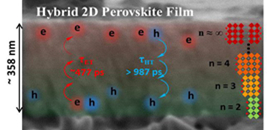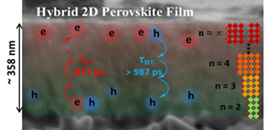Research News
-
 01 20, 2017DICP Researchers Discover Internal Photoinduced Electron and Hole Separation in Hybrid 2-Dimentional Perovskite FilmsThe research group led by Prof. JIN Shengye in Dalian Institute of Chemical Physics studied the charge carrier dynamics in 2D multi-layered perovskite films, using ultrafast transient absorption and photoluminescence spectroscopy. Researchers found that multiple perovskite phases inside 2D layered perovskite film (including n = 2, 3, 4 and ≈ ∞) naturally align in the order of n along the direction perpendicular to the substrate. Driven by the band alignment between 2D perovskites phases, researchers observed consecutive photoinduced electron transfer from small-n to large-n phases. And the hole transfers in the opposite direction on hundreds of picoseconds inside the 2D film with the thickness around 358 nm. This internal charge transfer efficiently separates electrons and holes to the upper and bottom surfaces of the films. The phenomenon is a unique property beneficial for applications in photovoltaics and other optoelectronics devices.
01 20, 2017DICP Researchers Discover Internal Photoinduced Electron and Hole Separation in Hybrid 2-Dimentional Perovskite FilmsThe research group led by Prof. JIN Shengye in Dalian Institute of Chemical Physics studied the charge carrier dynamics in 2D multi-layered perovskite films, using ultrafast transient absorption and photoluminescence spectroscopy. Researchers found that multiple perovskite phases inside 2D layered perovskite film (including n = 2, 3, 4 and ≈ ∞) naturally align in the order of n along the direction perpendicular to the substrate. Driven by the band alignment between 2D perovskites phases, researchers observed consecutive photoinduced electron transfer from small-n to large-n phases. And the hole transfers in the opposite direction on hundreds of picoseconds inside the 2D film with the thickness around 358 nm. This internal charge transfer efficiently separates electrons and holes to the upper and bottom surfaces of the films. The phenomenon is a unique property beneficial for applications in photovoltaics and other optoelectronics devices.
Two-dimensional (2D) layered perovskites (A)2(CH3NH3)n-1MnX3n+1 have recently emerged as an attractive material for applications in photovoltaics and other optoelectronic devices (A is a large aliphatic or aromatic alkylammonium cation working as an insulating layer, M is the metal cation, and X is the halide anion). It has demonstrated that 2D layered perovskite films actually comprised multiple perovskite phases (with various n values from 1, 2, 3 and 4 to near ∞), even though the films were intended to be prepared as a single-phase. This hybrid feature seems to be ineluctable in fabricating 2D films.
However, it's still a burning question that how the different perovskite phases align in the hybrid films. Moreover, it is also unclear whether the band alignment between different phases can induce energy funneling or instead charges separation.
The latter is especially important because it dictates the application of these hybrid 2D perovskite films. Energy funneling is useful for light emitting applications, whereas charge separation would be more beneficial for light conversion or detection.
The Hybrid 2D Perpvslite Film (Image by LENG Jing and JIN Shengye)
The research group led by Prof. JIN Shengye in Dalian Institute of Chemical Physics studied the charge carrier dynamics in 2D multi-layered perovskite films, using ultrafast transient absorption and photoluminescence spectroscopy. Researchers found that multiple perovskite phases inside 2D layered perovskite film (including n = 2, 3, 4 and ≈ ∞) naturally align in the order of n along the direction perpendicular to the substrate. Driven by the band alignment between 2D perovskites phases, researchers observed consecutive photoinduced electron transfer from small-n to large-n phases. And the hole transfers in the opposite direction on hundreds of picoseconds inside the 2D film with the thickness around 358 nm. This internal charge transfer efficiently separates electrons and holes to the upper and bottom surfaces of the films. The phenomenon is a unique property beneficial for applications in photovoltaics and other optoelectronics devices.
The related results were published in Journal of the American Chemical Society (DOI: 10.1021/jacs.6b12581). This work is financially supported by Ministry of Science and Technology (2016YFA0200602) and National Nature Science Foundation of China (2013CB834604). (Text and Image by LENG Jing and JIN Shengye)
Dr. LU Xinyi
Dalian Institute of Chemical Physics, Chinese Academy of Sciences,
457 Zhongshan Road, Dalian, 116023, China,
Tel: 86-411-84379201
E-mail: luxinyi@dicp.ac.cn -
 01 20, 2017DICP Researchers Discover Internal Photoinduced Electron and Hole Separation in Hybrid 2-Dimentional Perovskite FilmsThe research group led by Prof. JIN Shengye in Dalian Institute of Chemical Physics studied the charge carrier dynamics in 2D multi-layered perovskite films, using ultrafast transient absorption and photoluminescence spectroscopy. Researchers found that multiple perovskite phases inside 2D layered perovskite film (including n = 2, 3, 4 and ≈ ∞) naturally align in the order of n along the direction perpendicular to the substrate. Driven by the band alignment between 2D perovskites phases, researchers observed consecutive photoinduced electron transfer from small-n to large-n phases. And the hole transfers in the opposite direction on hundreds of picoseconds inside the 2D film with the thickness around 358 nm. This internal charge transfer efficiently separates electrons and holes to the upper and bottom surfaces of the films. The phenomenon is a unique property beneficial for applications in photovoltaics and other optoelectronics devices.
01 20, 2017DICP Researchers Discover Internal Photoinduced Electron and Hole Separation in Hybrid 2-Dimentional Perovskite FilmsThe research group led by Prof. JIN Shengye in Dalian Institute of Chemical Physics studied the charge carrier dynamics in 2D multi-layered perovskite films, using ultrafast transient absorption and photoluminescence spectroscopy. Researchers found that multiple perovskite phases inside 2D layered perovskite film (including n = 2, 3, 4 and ≈ ∞) naturally align in the order of n along the direction perpendicular to the substrate. Driven by the band alignment between 2D perovskites phases, researchers observed consecutive photoinduced electron transfer from small-n to large-n phases. And the hole transfers in the opposite direction on hundreds of picoseconds inside the 2D film with the thickness around 358 nm. This internal charge transfer efficiently separates electrons and holes to the upper and bottom surfaces of the films. The phenomenon is a unique property beneficial for applications in photovoltaics and other optoelectronics devices.
Two-dimensional (2D) layered perovskites (A)2(CH3NH3)n-1MnX3n+1 have recently emerged as an attractive material for applications in photovoltaics and other optoelectronic devices (A is a large aliphatic or aromatic alkylammonium cation working as an insulating layer, M is the metal cation, and X is the halide anion). It has demonstrated that 2D layered perovskite films actually comprised multiple perovskite phases (with various n values from 1, 2, 3 and 4 to near ∞), even though the films were intended to be prepared as a single-phase. This hybrid feature seems to be ineluctable in fabricating 2D films.
However, it's still a burning question that how the different perovskite phases align in the hybrid films. Moreover, it is also unclear whether the band alignment between different phases can induce energy funneling or instead charges separation.
The latter is especially important because it dictates the application of these hybrid 2D perovskite films. Energy funneling is useful for light emitting applications, whereas charge separation would be more beneficial for light conversion or detection.
The Hybrid 2D Perpvslite Film (Image by LENG Jing and JIN Shengye)
The research group led by Prof. JIN Shengye in Dalian Institute of Chemical Physics studied the charge carrier dynamics in 2D multi-layered perovskite films, using ultrafast transient absorption and photoluminescence spectroscopy. Researchers found that multiple perovskite phases inside 2D layered perovskite film (including n = 2, 3, 4 and ≈ ∞) naturally align in the order of n along the direction perpendicular to the substrate. Driven by the band alignment between 2D perovskites phases, researchers observed consecutive photoinduced electron transfer from small-n to large-n phases. And the hole transfers in the opposite direction on hundreds of picoseconds inside the 2D film with the thickness around 358 nm. This internal charge transfer efficiently separates electrons and holes to the upper and bottom surfaces of the films. The phenomenon is a unique property beneficial for applications in photovoltaics and other optoelectronics devices.
The related results were published in Journal of the American Chemical Society (DOI: 10.1021/jacs.6b12581). This work is financially supported by Ministry of Science and Technology (2016YFA0200602) and National Nature Science Foundation of China (2013CB834604). (Text and Image by LENG Jing and JIN Shengye)
Dr. LU Xinyi
Dalian Institute of Chemical Physics, Chinese Academy of Sciences,
457 Zhongshan Road, Dalian, 116023, China,
Tel: 86-411-84379201
E-mail: luxinyi@dicp.ac.cn -
 01 18, 2017China's First Manned Fuel Cell Aircraft Successfully Completes Maiden FlightDecember 27, 2016, the China's first manned fuel cell aircraft powered by 20kW proton exchange membrane fuel cell (PEMFC) successfully completed its maiden flight in Northeast of China. The 20kW PEMFC served as power supply was developed by proton exchange membrane fuel cell research team in DICP. The successfully flight means a breakthrough progress in the domestic aviation fuel cell technology. It also makes China the third country having such technology after the United States and Germany.
01 18, 2017China's First Manned Fuel Cell Aircraft Successfully Completes Maiden FlightDecember 27, 2016, the China's first manned fuel cell aircraft powered by 20kW proton exchange membrane fuel cell (PEMFC) successfully completed its maiden flight in Northeast of China. The 20kW PEMFC served as power supply was developed by proton exchange membrane fuel cell research team in DICP. The successfully flight means a breakthrough progress in the domestic aviation fuel cell technology. It also makes China the third country having such technology after the United States and Germany.
December 27, 2016, the China's first manned fuel cell aircraft powered by 20kW proton exchange membrane fuel cell (PEMFC) successfully completed its maiden flight in Northeast of China. The 20kW PEMFC served as power supply was developed by proton exchange membrane fuel cell research team in DICP. The successfully flight means a breakthrough progress in the domestic aviation fuel cell technology. It also makes China the third country having such technology after the United States and Germany.
The research team began to develop the 20kW level H2-PEMFC technology for aerostatic application since 2014. The key technical issues such as efficient water management, heat management, high security and high reliability have been broken in the past two years of research. The power system completed ground joint test, environmental adaptability test and high speed test and so on. In this flight, the performance, safety, reliability and environmental adaptability of fuel cell system can all reach the technical requirements.
Previously, the research team has developed 10kW level type-I, type-II and type-III aviation PEMFC power system, which fills the gap in this field of technology. Among them, type I system was applied in China's first fuel cell powered airship, "Zhiyuan No. 1" in November 2009; type II system was used in China's first fuel cell unmanned aerial vehicles, "Thunderbird" in July 2012; type III system was served as tail driving force of the airship, which completes the high altitude environmental adaptability test. This manned flight further confirms that the fuel cell power supply system not only shows good safety and reliability, but also demonstrates excellent storage, start up and output performance at -20oC.
China's First Manned Fuel Cell Aircraft(Imaged by LIU Da and ZHOU Li)
Fuel cell is efficient and environmentally friendly power generation equipment and becomes an important development direction of new energy technology. It can be widely used in power supply, distributed power station, mobile power and so on. The aircraft powered by fuel cell becomes an international research topic due to the advantages of low noise, zero pollution and long battery life. (Text by ZHOU Li / Imaged by LIU Da and ZHOU Li)
Dr. LU Xinyi
Dalian Institute of Chemical Physics, Chinese Academy of Sciences,
457 Zhongshan Road, Dalian, 116023, China,
Tel: 86-411-84379201,
E-mail: luxinyi@dicp.ac.cn
-
 01 18, 2017China's First Manned Fuel Cell Aircraft Successfully Completes Maiden FlightDecember 27, 2016, the China's first manned fuel cell aircraft powered by 20kW proton exchange membrane fuel cell (PEMFC) successfully completed its maiden flight in Northeast of China. The 20kW PEMFC served as power supply was developed by proton exchange membrane fuel cell research team in DICP. The successfully flight means a breakthrough progress in the domestic aviation fuel cell technology. It also makes China the third country having such technology after the United States and Germany.
01 18, 2017China's First Manned Fuel Cell Aircraft Successfully Completes Maiden FlightDecember 27, 2016, the China's first manned fuel cell aircraft powered by 20kW proton exchange membrane fuel cell (PEMFC) successfully completed its maiden flight in Northeast of China. The 20kW PEMFC served as power supply was developed by proton exchange membrane fuel cell research team in DICP. The successfully flight means a breakthrough progress in the domestic aviation fuel cell technology. It also makes China the third country having such technology after the United States and Germany.
December 27, 2016, the China's first manned fuel cell aircraft powered by 20kW proton exchange membrane fuel cell (PEMFC) successfully completed its maiden flight in Northeast of China. The 20kW PEMFC served as power supply was developed by proton exchange membrane fuel cell research team in DICP. The successfully flight means a breakthrough progress in the domestic aviation fuel cell technology. It also makes China the third country having such technology after the United States and Germany.
The research team began to develop the 20kW level H2-PEMFC technology for aerostatic application since 2014. The key technical issues such as efficient water management, heat management, high security and high reliability have been broken in the past two years of research. The power system completed ground joint test, environmental adaptability test and high speed test and so on. In this flight, the performance, safety, reliability and environmental adaptability of fuel cell system can all reach the technical requirements.
Previously, the research team has developed 10kW level type-I, type-II and type-III aviation PEMFC power system, which fills the gap in this field of technology. Among them, type I system was applied in China's first fuel cell powered airship, "Zhiyuan No. 1" in November 2009; type II system was used in China's first fuel cell unmanned aerial vehicles, "Thunderbird" in July 2012; type III system was served as tail driving force of the airship, which completes the high altitude environmental adaptability test. This manned flight further confirms that the fuel cell power supply system not only shows good safety and reliability, but also demonstrates excellent storage, start up and output performance at -20oC.
China's First Manned Fuel Cell Aircraft(Imaged by LIU Da and ZHOU Li)
Fuel cell is efficient and environmentally friendly power generation equipment and becomes an important development direction of new energy technology. It can be widely used in power supply, distributed power station, mobile power and so on. The aircraft powered by fuel cell becomes an international research topic due to the advantages of low noise, zero pollution and long battery life. (Text by ZHOU Li / Imaged by LIU Da and ZHOU Li)
Dr. LU Xinyi
Dalian Institute of Chemical Physics, Chinese Academy of Sciences,
457 Zhongshan Road, Dalian, 116023, China,
Tel: 86-411-84379201,
E-mail: luxinyi@dicp.ac.cn
-
 01 16, 2017China opens unique free electron laser facility
01 16, 2017China opens unique free electron laser facility -
 01 16, 2017China opens unique free electron laser facility
01 16, 2017China opens unique free electron laser facility